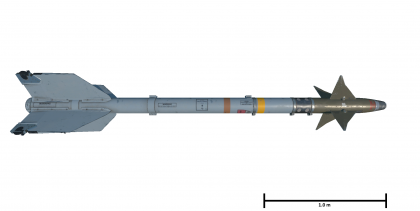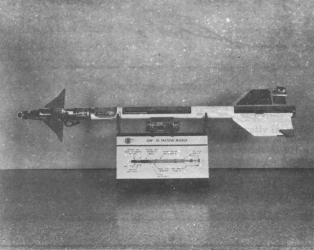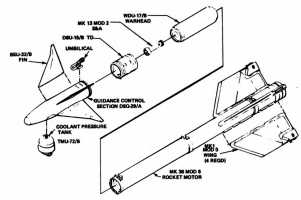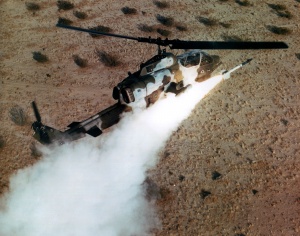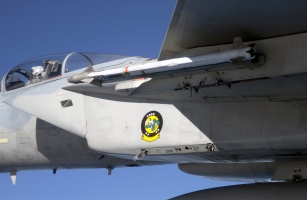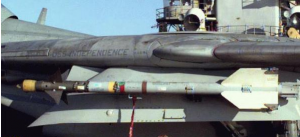Difference between revisions of "AIM-9L Sidewinder"
Inceptor57 (talk | contribs) m |
Inceptor57 (talk | contribs) (→History: Added images to history section) |
||
| Line 57: | Line 57: | ||
===Development=== | ===Development=== | ||
The experience with the AIM-9 Sidewinders in the Vietnam War and Yom Kippur War showed that there were still many improvements that could be made to the Sidewinder's performance. Low-altitude performance was poor due to environmental interferences on the Sidewinder's IR seeker, and the IR seeker was only able to attack from the rear to lock onto the engine exhaust of an enemy aircraft. Improving the Sidewinder's seeker capabilities to solve these issues became the key improvement for the next Sidewinder generation.<ref name="Ausairpower_Sidewinder">Kopp 2014</ref> | The experience with the AIM-9 Sidewinders in the Vietnam War and Yom Kippur War showed that there were still many improvements that could be made to the Sidewinder's performance. Low-altitude performance was poor due to environmental interferences on the Sidewinder's IR seeker, and the IR seeker was only able to attack from the rear to lock onto the engine exhaust of an enemy aircraft. Improving the Sidewinder's seeker capabilities to solve these issues became the key improvement for the next Sidewinder generation.<ref name="Ausairpower_Sidewinder">Kopp 2014</ref> | ||
| + | [[File:Cutaway_of_the_AIM-9L.png|x250px|right|thumb|none|An AIM-9L missile on display. The canard fin shape is the most distinctive external feature of the AIM-9L.]] | ||
The United States Navy had their own development team within China Lake that set to work improving their Sidewinders, which has so far culminated from the [[AIM-9B Sidewinder|AIM-9B]] to the [[AIM-9D Sidewinder|AIM-9D]], [[AIM-9G Sidewinder|AIM-9G]] and their latest AIM-9H. The US Air Force had their own development of the Sidewinder splitting off from the US Navy's AIM-9B to the [[AIM-9E Sidewinder|AIM-9E]] and [[AIM-9J Sidewinder|AIM-9J]]. The US Navy and US Air Force's Sidewinder models were not compatible between the two service branches due to differences in seeker cooling methods. The United States Air Force desired to continue their own missile program named "CLAW", which called for the use of smaller, cheaper missiles so more could be fired at a time. William Perry, the Defense Department's deputy director of research and engineering, disapproved of this path and told the US Air Force to work with the US Navy to work together on a common IR missile for both service branches. The US Air Force, therefore, cooperated with the US Navy's China Lake team to share specifications and technology to produce the next missile. The US Navy would designate this program as the ''AIM-9H Product Improvement Package'' (PIP).<ref name="Westrum_Sidewinder9L">Westrum 2013, p.191-193</ref> | The United States Navy had their own development team within China Lake that set to work improving their Sidewinders, which has so far culminated from the [[AIM-9B Sidewinder|AIM-9B]] to the [[AIM-9D Sidewinder|AIM-9D]], [[AIM-9G Sidewinder|AIM-9G]] and their latest AIM-9H. The US Air Force had their own development of the Sidewinder splitting off from the US Navy's AIM-9B to the [[AIM-9E Sidewinder|AIM-9E]] and [[AIM-9J Sidewinder|AIM-9J]]. The US Navy and US Air Force's Sidewinder models were not compatible between the two service branches due to differences in seeker cooling methods. The United States Air Force desired to continue their own missile program named "CLAW", which called for the use of smaller, cheaper missiles so more could be fired at a time. William Perry, the Defense Department's deputy director of research and engineering, disapproved of this path and told the US Air Force to work with the US Navy to work together on a common IR missile for both service branches. The US Air Force, therefore, cooperated with the US Navy's China Lake team to share specifications and technology to produce the next missile. The US Navy would designate this program as the ''AIM-9H Product Improvement Package'' (PIP).<ref name="Westrum_Sidewinder9L">Westrum 2013, p.191-193</ref> | ||
| − | The package prioritized improving the seeker with an indium antimonide seeker, which could detect the longer-wavelength infrared radiation given out of warm surfaces of aircraft parts, allowing the missile to obtain all-aspect capability (ALASCA) in acquiring targets.<ref name="Westrum_Sidewinder9L"/> Other improvements with the AIM-9H PIP were the long-span pointed double-delta canards, a new MK 36 solid-fuel rocket motor, WDU-17/B warhead featuring double-layer continuous-rod scheme, and a DSU-15/B Active Optical Target Detector (AOTD) laser proximity fuse system <ref name="AirVector_Sidewinder">Goebel 2021</ref><ref name="Designation_Sidewinder">Parsch 2008</ref> The cooling system was improved to | + | The package prioritized improving the seeker with an indium antimonide seeker, which could detect the longer-wavelength infrared radiation given out of warm surfaces of aircraft parts, allowing the missile to obtain all-aspect capability (ALASCA) in acquiring targets.<ref name="Westrum_Sidewinder9L"/> Other improvements with the AIM-9H PIP were the long-span pointed double-delta canards, a new MK 36 solid-fuel rocket motor, WDU-17/B warhead featuring double-layer continuous-rod scheme, and a DSU-15/B Active Optical Target Detector (AOTD) laser proximity fuse system <ref name="AirVector_Sidewinder">Goebel 2021</ref><ref name="Designation_Sidewinder">Parsch 2008</ref> The cooling system was improved to a TMU/72/B argon-gas cooling system that was contained within the missile's seeker, which allowed for use on both USAF and USN missile launchers.<ref name="Ausairpower_Sidewinder"/> The one feature that complicated the US Navy and US Air Force cooperation with the missile was the reticle seeker, with the US Navy desiring an amplitude-modulated (AM) seeker while the US Air Force desired a frequency-modulated (FM) seeker. An AM-FM system was developed by Raytheon,<ref name="Westrum_Sidewinder9L"/>, which allowed the Sidewinder to use both traditional AM reticle that is effective in cloudy backgrounds with the benefit of the FM reticle reducing seeker error signal inputs from the target's increasing size as the seeker gets closer.<ref name="Westrum_AMSeeker">Westrum 2013, p.137</ref><ref name="Ausairpower_Sidewinder"/> |
| + | [[File:Breakout of the AIM-9L.png|x200px|left|none|thumb|An exploded diagram of the AIM-9L and its components.]] | ||
Another improvement Raytheon introduced in the AIM-9H PIP was a rate bias that caused the missile to aim slightly ahead of an aircraft's hot afterburner. Issues arose when the missiles' rate bias adjusts too far ahead and missed the aircraft from the front. Consultation with General Dynamics revealed similar issues had arose during the development of the [[AIM-92 Stinger|FIM-92 Stinger]] missile, and the proper adjustments were made to solve the issue.<ref name="Westrum_Sidewinder9L"/> Sometime prior to 1975, the AIM-9H PIP would be designated as the '''AIM-9L'''. By 1975, the AIM-9L was tested in a joint navy-air force evaluation. Satisfied with the results, the AIM-9L missile was put into production in 1976 with both Raytheon and Ford Aerospace for a missile that was now jointly serving the United States Air Force and Navy.<ref name="Westrum_9LAcceptance">Westrum 2013, p.196</ref> | Another improvement Raytheon introduced in the AIM-9H PIP was a rate bias that caused the missile to aim slightly ahead of an aircraft's hot afterburner. Issues arose when the missiles' rate bias adjusts too far ahead and missed the aircraft from the front. Consultation with General Dynamics revealed similar issues had arose during the development of the [[AIM-92 Stinger|FIM-92 Stinger]] missile, and the proper adjustments were made to solve the issue.<ref name="Westrum_Sidewinder9L"/> Sometime prior to 1975, the AIM-9H PIP would be designated as the '''AIM-9L'''. By 1975, the AIM-9L was tested in a joint navy-air force evaluation. Satisfied with the results, the AIM-9L missile was put into production in 1976 with both Raytheon and Ford Aerospace for a missile that was now jointly serving the United States Air Force and Navy.<ref name="Westrum_9LAcceptance">Westrum 2013, p.196</ref> | ||
| Line 67: | Line 69: | ||
===Future Sidewinder variants=== | ===Future Sidewinder variants=== | ||
| + | [[File:AH-1W_VX-5_launching_AIM-9L_1987.jpg|right|thumb|none|An AH-1W SuperCobra fires a AIM-9L from a wing-mounted missile launcher at China Lake.]] | ||
| + | |||
Though AIM-9L was a successful Sidewinder variant, there were still more features and improvements to be introduced into the model. Infrared Counter-Counterneasure (IRCCM) capability, a smaller smoke signature from the motor, and an improved WGU-4/B guidance system were implemented into the AIM-9L PIP that became the ''AIM-9M'', which saw use during the Gulf War.<ref name="Designation_Sidewinder"/> The next significant AIM-9 variant to be developed was the ''AIM-9R'', which attempted to evolve the AIM-9 design with the use of a charge-coupled device (CCD) detector, allowing the missile to use an imaging system to track the target. However, cost overruns, staff mismanagement, use of expensive and complicated components, and the fact the imaging system could not work in the night caused the backers of the program to lose faith and the missile was cancelled by the US Navy in December 1991.<ref name="Westrum_9R">Westrum 2013, p.198-203</ref> | Though AIM-9L was a successful Sidewinder variant, there were still more features and improvements to be introduced into the model. Infrared Counter-Counterneasure (IRCCM) capability, a smaller smoke signature from the motor, and an improved WGU-4/B guidance system were implemented into the AIM-9L PIP that became the ''AIM-9M'', which saw use during the Gulf War.<ref name="Designation_Sidewinder"/> The next significant AIM-9 variant to be developed was the ''AIM-9R'', which attempted to evolve the AIM-9 design with the use of a charge-coupled device (CCD) detector, allowing the missile to use an imaging system to track the target. However, cost overruns, staff mismanagement, use of expensive and complicated components, and the fact the imaging system could not work in the night caused the backers of the program to lose faith and the missile was cancelled by the US Navy in December 1991.<ref name="Westrum_9R">Westrum 2013, p.198-203</ref> | ||
The AIM-9L and future variants introduced many radical features that the United States deemed too sensitive for all allies, and export variants were produced that lacked some of the newer features. These export variants were labeled as ''AIM-9N'', ''[[AIM-9P Sidewinder|AIM-9P]]'', and ''AIM-9S''.<ref name="Designation_Sidewinder"/> | The AIM-9L and future variants introduced many radical features that the United States deemed too sensitive for all allies, and export variants were produced that lacked some of the newer features. These export variants were labeled as ''AIM-9N'', ''[[AIM-9P Sidewinder|AIM-9P]]'', and ''AIM-9S''.<ref name="Designation_Sidewinder"/> | ||
| + | [[File:AIM-9X_F-15C_2002.jpg|x200px|left|thumb|none|An AIM-9X Sidewinder on an F-15C.]] | ||
The most recent Sidewinder variant to see use is the ''AIM-9X'', which uses the Mk 36 motor and WDU-17/B warhead from the AIM-9M, but the air frame had been redesigned with smaller fins and canards for lower drag and better flight performance. Rollerons have been removed from the Sidewinder's design as the flight control system was sophisticated enough to no longer need them. The WPU-17/B propulsion section uses a jet-vane steering system to steer the Sidewinder with thrust-vectoring. The result was a more compact missile that could fit within a fighter's internal bay, such as the F-22 and F-35.<ref name="Designation_Sidewinder"/> The biggest improvement of the AIM-9X over the predecessors was the guidance, using a seeker that was developed for the AIM-132 {{Annotation|ASRAAM|Advanced Short-Range Anti-Air Missile}} with an imaging infrared array, cooled by a Stirling-cycle cryocooler.<ref name="AirVector_Sidewinder"/> The AIM-9X also introduced an "Off-Boresight" capability, allowing the missile to be used with the Joint Helmet-Mounted Cueing System (JHMCS) to acquire target with the pilot's helmet.<ref name="Designation_Sidewinder"/><ref name="AirVector_Sidewinder"/> Continually seeing development as late as 2019,<ref name="Drive_AIM9X">Rogoway & Trevithick 2019</ref> the AIM-9X looks to be the main Sidewinder model for the 21st century aerospace. | The most recent Sidewinder variant to see use is the ''AIM-9X'', which uses the Mk 36 motor and WDU-17/B warhead from the AIM-9M, but the air frame had been redesigned with smaller fins and canards for lower drag and better flight performance. Rollerons have been removed from the Sidewinder's design as the flight control system was sophisticated enough to no longer need them. The WPU-17/B propulsion section uses a jet-vane steering system to steer the Sidewinder with thrust-vectoring. The result was a more compact missile that could fit within a fighter's internal bay, such as the F-22 and F-35.<ref name="Designation_Sidewinder"/> The biggest improvement of the AIM-9X over the predecessors was the guidance, using a seeker that was developed for the AIM-132 {{Annotation|ASRAAM|Advanced Short-Range Anti-Air Missile}} with an imaging infrared array, cooled by a Stirling-cycle cryocooler.<ref name="AirVector_Sidewinder"/> The AIM-9X also introduced an "Off-Boresight" capability, allowing the missile to be used with the Joint Helmet-Mounted Cueing System (JHMCS) to acquire target with the pilot's helmet.<ref name="Designation_Sidewinder"/><ref name="AirVector_Sidewinder"/> Continually seeing development as late as 2019,<ref name="Drive_AIM9X">Rogoway & Trevithick 2019</ref> the AIM-9X looks to be the main Sidewinder model for the 21st century aerospace. | ||
Revision as of 18:33, 23 November 2021
Contents
Description
The AIM-9L is an American infrared homing air-to-air missile, it was introduced in Update 1.85 "Supersonic".
Vehicles equipped with this weapon
General info
- Mass: 84 kg
- Guidance: IR
- Aspects: All-Aspects
- Weapon Lock range in rear-aspect: 6.50 km
- Weapon Lock range in all-aspect: 3.00 km
- Launch range: 18.00 km
- Maximum speed: Mach 2.5
- Maximum overload: 30 G
- Explosive type: HBX
- Explosive mass: 3.54 kg
- TNT equivalent: 5.66 kg
Effective damage
Describe the type of damage produced by this type of missile (high explosive, splash damage, etc)
Comparison with analogues
Give a comparative description of missiles that have firepower equal to this weapon.
Usage in battles
Describe situations when you would utilise this missile in-game (vehicle, pillbox, base, etc)
Pros and cons
Pros:
- Lock on Fire-And-Forget missile
- 30G Max overload
- 18 km maximum range if the hostile plane were to go in a straight line
- Up to 5 km in which the missile can turn (5.2 s of burn time)
- 6.5 km rear-aspect lock-on
- 3 km all-aspect lock on
Cons:
- Flares can distract the missile
- Friendly or Enemy missile could distract the missile
- Very high speed loss due to weak engine and high drag coefficient
- IRCM modules acts as a shield against the missile
History
Development
The experience with the AIM-9 Sidewinders in the Vietnam War and Yom Kippur War showed that there were still many improvements that could be made to the Sidewinder's performance. Low-altitude performance was poor due to environmental interferences on the Sidewinder's IR seeker, and the IR seeker was only able to attack from the rear to lock onto the engine exhaust of an enemy aircraft. Improving the Sidewinder's seeker capabilities to solve these issues became the key improvement for the next Sidewinder generation.[1]
The United States Navy had their own development team within China Lake that set to work improving their Sidewinders, which has so far culminated from the AIM-9B to the AIM-9D, AIM-9G and their latest AIM-9H. The US Air Force had their own development of the Sidewinder splitting off from the US Navy's AIM-9B to the AIM-9E and AIM-9J. The US Navy and US Air Force's Sidewinder models were not compatible between the two service branches due to differences in seeker cooling methods. The United States Air Force desired to continue their own missile program named "CLAW", which called for the use of smaller, cheaper missiles so more could be fired at a time. William Perry, the Defense Department's deputy director of research and engineering, disapproved of this path and told the US Air Force to work with the US Navy to work together on a common IR missile for both service branches. The US Air Force, therefore, cooperated with the US Navy's China Lake team to share specifications and technology to produce the next missile. The US Navy would designate this program as the AIM-9H Product Improvement Package (PIP).[2]
The package prioritized improving the seeker with an indium antimonide seeker, which could detect the longer-wavelength infrared radiation given out of warm surfaces of aircraft parts, allowing the missile to obtain all-aspect capability (ALASCA) in acquiring targets.[2] Other improvements with the AIM-9H PIP were the long-span pointed double-delta canards, a new MK 36 solid-fuel rocket motor, WDU-17/B warhead featuring double-layer continuous-rod scheme, and a DSU-15/B Active Optical Target Detector (AOTD) laser proximity fuse system [3][4] The cooling system was improved to a TMU/72/B argon-gas cooling system that was contained within the missile's seeker, which allowed for use on both USAF and USN missile launchers.[1] The one feature that complicated the US Navy and US Air Force cooperation with the missile was the reticle seeker, with the US Navy desiring an amplitude-modulated (AM) seeker while the US Air Force desired a frequency-modulated (FM) seeker. An AM-FM system was developed by Raytheon,[2], which allowed the Sidewinder to use both traditional AM reticle that is effective in cloudy backgrounds with the benefit of the FM reticle reducing seeker error signal inputs from the target's increasing size as the seeker gets closer.[5][1]
Another improvement Raytheon introduced in the AIM-9H PIP was a rate bias that caused the missile to aim slightly ahead of an aircraft's hot afterburner. Issues arose when the missiles' rate bias adjusts too far ahead and missed the aircraft from the front. Consultation with General Dynamics revealed similar issues had arose during the development of the FIM-92 Stinger missile, and the proper adjustments were made to solve the issue.[2] Sometime prior to 1975, the AIM-9H PIP would be designated as the AIM-9L. By 1975, the AIM-9L was tested in a joint navy-air force evaluation. Satisfied with the results, the AIM-9L missile was put into production in 1976 with both Raytheon and Ford Aerospace for a missile that was now jointly serving the United States Air Force and Navy.[6]
Foreign users were also sought out for the AIM-9L. In one case, the AIM-9L was contested against the German company Bodensee Geratechnik (BGT), which had developed an ALASCA seeker for a proposed Viper missile. To resolve this and bring BGT to help produce AIM-9Ls to European allies, the US Navy and Raytheon waived license and R&D fees for the AIM-9L, causing the end of the Viper missile development and provided AIM-9Ls to Great Britain, Norway, and Germany. Japan were also given the license to produce AIM-9Ls, which was performed by Mitsubishi. Between Raytheon, Ford, BGT, and Mitsubishi, more than 16,000 AIM-9L Sidewinders have been built since their production started.[4]
Future Sidewinder variants
Though AIM-9L was a successful Sidewinder variant, there were still more features and improvements to be introduced into the model. Infrared Counter-Counterneasure (IRCCM) capability, a smaller smoke signature from the motor, and an improved WGU-4/B guidance system were implemented into the AIM-9L PIP that became the AIM-9M, which saw use during the Gulf War.[4] The next significant AIM-9 variant to be developed was the AIM-9R, which attempted to evolve the AIM-9 design with the use of a charge-coupled device (CCD) detector, allowing the missile to use an imaging system to track the target. However, cost overruns, staff mismanagement, use of expensive and complicated components, and the fact the imaging system could not work in the night caused the backers of the program to lose faith and the missile was cancelled by the US Navy in December 1991.[7]
The AIM-9L and future variants introduced many radical features that the United States deemed too sensitive for all allies, and export variants were produced that lacked some of the newer features. These export variants were labeled as AIM-9N, AIM-9P, and AIM-9S.[4]
The most recent Sidewinder variant to see use is the AIM-9X, which uses the Mk 36 motor and WDU-17/B warhead from the AIM-9M, but the air frame had been redesigned with smaller fins and canards for lower drag and better flight performance. Rollerons have been removed from the Sidewinder's design as the flight control system was sophisticated enough to no longer need them. The WPU-17/B propulsion section uses a jet-vane steering system to steer the Sidewinder with thrust-vectoring. The result was a more compact missile that could fit within a fighter's internal bay, such as the F-22 and F-35.[4] The biggest improvement of the AIM-9X over the predecessors was the guidance, using a seeker that was developed for the AIM-132 ASRAAM with an imaging infrared array, cooled by a Stirling-cycle cryocooler.[3] The AIM-9X also introduced an "Off-Boresight" capability, allowing the missile to be used with the Joint Helmet-Mounted Cueing System (JHMCS) to acquire target with the pilot's helmet.[4][3] Continually seeing development as late as 2019,[8] the AIM-9X looks to be the main Sidewinder model for the 21st century aerospace.
Media
- Videos
See also
External links
- References
- Bibliography
- Goebel, Greg. "The Falcon & Sidewinder Air-To-Air Missiles." Air Vectors, 01 Jul. 2021, Website. Accessed on 21 Nov. 2021.
- Hollway, Don. "The AIM-9 Sidewinder: Fox Two!" HistoryNet, Website. Accessed on 21 Nov. 2021.
- Kopp, Carlo. "The Sidewinder Story: The Evolution of the AIM-9 Missile." Air Power Australia, 27 Jan 2014, Website. Accessed on 21 Nov. 2021.
- Parsch, Andreas. "AIM-9." Directory of U.S. Military Rockets and Missiles, Designation-Systems.Net, 09 July 2008, Website. Accessed on 21 Nov. 2021.
- Westrum, Ron. Sidewinder; Creative Missile Development at China Lake. Naval Institute Press, 30 Sep. 2013.


